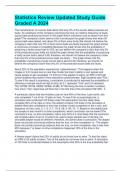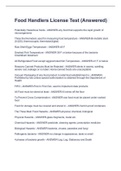Statistics Review Updated Study Guide Graded A 2024 The manufacturer of a soccer ball claims that only 3% of the soccer balls produced are faulty. An employee of this company examines the long -run relative frequency of faulty soccer balls produced as shown in the graph.Which conclusion can be drawn from thi s graph?The company's claim seems to be true because the graph shows that when 50 soccer balls were tested, only about 3% of them were faulty.We should not believe the company's claim that only 3% of their soccer balls are faulty because this graph shows a continuous increase in probability.Because the graph shows that the probability of producing a faulty soccer ball is 0.03, we can believe the company's claim that only 3% of the produced soccer balls are faultyThe graph shows that the probability of produ cing a faulty soccer ball is about 0.06; therefore, we should not believe the company's claim that only 3% of the produced soccer balls are faulty. - The graph shows that the probability of producing a faulty soccer ball is about 0.06; therefore, we should not believe the company's claim that only 3% of the produced soccer balls are faulty. About 20% of the population experiences "cybersickness." This happens when the images in 3 -D movies look so real they hinder the brain's ability to sort signals and cause people to get nauseated. To find out if this applies to teens, an SRS of 30 high scho ol students was asked if they experience cybersickness. Eight students said "Yes." To see if this result is surprising, a simulation is conducted to estimate the probability of obtaining a sample result as high as this.Let 0 -1 represent "Yes" and 2 -9 repre sent "No."42188, 55736, 50953, 82496, 41985, 07738.Using the line of random numbers, how many "Yes" responses will there be in the first trial of the simulation?241526 - 4 A contractor claims that she finishes a job on time 90% of the time. Last month, she only completed 7 out of her 10 jobs on time. To see if this is surprisingly low, a simulation was conducted 100 times under the assumption that she really does complete 90 % of her jobs on time.The dotplot contains 100 trials of this simulation.A dotplot titled jobs completed on time has number of jobs completed on the x -axis, and frequency on the y -axis. 5, 1; 6, 3; 7, 15; 8, 26; 9, 45; 10, 11.Based on this dotplot and the sample of last month's on -time completions, which conclusion can be drawn?The contractor's true, on -time completion rate is only 50%.It is most likely that the contractor will complete about 9 out of 10 jobs.If we used a larger sample size of 40 jobs, the simulated dotplot would be different; therefore, we cannot draw a conclusion.The dotplot does not provide convincing evidence that her true, on -time completion ra - The dotplot does not provide convincing evidence that her true, on -time completion rate is less than 90% because 7 or fewer on -time completions happened 19% of the time in the simulation. A fitness expert claims that 25% of adults do not know how to swim. To test this claim, an SRS of 20 adults is taken. Two of the adults do not know how to swim. A simulation of 100 trials is conducted based on the assumption that 25% is the true probabilit y that an adult does not know how to swim.A dotplot titled Nonswimmers has number of nonswimmers on the x -axis, and frequency on the y -axis. 1, 3; 2, 9; 3, 16; 4, 18; 5, 25; 6, 17; 7, 9; 8, 3; 9, 1.Based on the dotplot of the simulation results and the sample of 20 adults, which conclusion can be made?The actual probability that an adult cannot swim is only 12%.It is clear that exactly 5 out of 20 adults will be nonswimmers.If we continued to take more samples of 10 adults, the center of the distribution would shi ft to 2.There is about a 12% chance of 2 or fewer nonswimmers in a group of 20. This is not unusual and is not convincing evidence that the true probabilit - There is about a 12% chance of 2 or fewer nonswimmers in a group of 20. This is not unusual and is not convincing evidence that the true probability that an adult cannot swim is less than 25%. An online news report claims that 50% of online news readers work in the business industry. To test this claim, a researcher takes an SRS of 25 online news readers. Nine of them work in the business industry. A simulation of 65 trials was conducted under t he assumption that 50% of online news readers really do work in the business industry.A dotplot titled online readers and the business industry has number of readers from the food industry on the x -axis, and frequency on the y -axis. 8, 1; 9, 2; 10, 6; 11, 9; 12, 13; 13, 15; 14, 9; 15, 6; 16, 2; 17, 0; 18, 1; 19, 1.Based on this dotplot and the sample of 25 online news readers, which conclusion can be drawn?Since 0.36 of the sample works in the business industry, 0.36 is the true probability that an online n ews reader works in the business industry.It is most likely that, out of 25 online readers, between 12 and 13 work in the business industry.Because there appear t - There is about a 0.046 chance that 9 or fewer online readers work in the business industry. This is unusual and is convincing evidence that less than 50% of online readers work in the business industry. Forty percent of the beads in a bag of more than 10,000 beads are yellow. Suzy pulls out 10 beads, one at a time with replacement, and notes that eight of these beads are yellow. She says the next bead pulled out will not be yellow because a yellow bead ha s been pulled out too many times in a row.Is Suzy's reasoning correct?Yes, it is unlikely that she would pull out so many yellow beads, so the next bead cannot be yellow.Yes, Suzy has correctly decided that more than 40% of the beads in this large bag are yellow.No, if a yellow bead is pulled 8 out of 10 times, the bag of beads is unfairly weighted toward yellow.No, it is true that the probability of pulling a yellow bead is 0.40, but Suzy should not expect that exactly 40% of such a small number of beads p ulled will be yellow. - No, it is true that the probability of pulling a yellow bead is 0.40, but Suzy should not expect that exactly 40% of such a small number of beads pulled will be yellow. Anna says there is a 0.15 probability that at least one of her shoes comes untied during her morning jogs.Which is the correct interpretation of this probability?When Anna jogs tomorrow morning, 15% of her shoes will come untied.If Anna jogs 100 mornings, then at least one shoe will come untied exactly 15 times.Fifteen percent of all joggers will experience a shoe that comes untied when they jog.If you take a very large sample of Anna's morning jogs, at least one shoe will come untied about 15% of the time. - If you take a very large sample of Anna's morning jogs, at least one shoe will come untied about 15% of the time. Carlos thinks the traffic light to get out of his neighborhood is red more often than green. He decides to collect data to determine the probability of the light being red upon his approach. The graph of his long -run relative frequencies is shown.A graph t itled Carlos apostrophe s red light has frequency on the x -axis, and probability on the y -axis. The graph levels out around y = 0.63.Which conclusion can be drawn from this graph?About half of the time, the traffic light is red when Carlos leaves his neigh borhood.About 63% of the time, the traffic light is red when Carlos leaves his neighborhood.If the true probability that the traffic light is red when Carlos leaves his neighborhood is 0.63, there would be no variation in the graph.The probability that the traffic light is red when Carlos leaves his neighborhood cannot be determined from this graph because there is no pattern in a long series of traffic lights. - About 63% of the time, the traffic light is red when Carlos leaves his neighborhood. A study reported that about half of high school seniors study for upcoming math tests. To find out if this applies to seniors at Garfield High School, an SRS of 30 seniors was asked if they study for their math tests. Nineteen responded "Yes."A dotplot is provided showing the results of 40 trials of this simulation.A dotplot titled seniors who study for math tests have number of seniors who responded yes on the x -axis, and frequency on the y -axis. 12, 2; 13, 5; 14, 6; 15, 11; 16, 9; 17, 4; 18, 2; 9, 0; 20, 1.Does this provide convincing evidence that seniors at Garfield High School study more than the report stated?No, there is an outlier at 20.No, there were outcomes as low as 12.Yes, only one trial had a result of 19 or larger.Yes, more than half of the si mulated results are over 15. - Yes, only one trial had a result of 19 or larger. A teacher claims that there is a 50% chance that she will collect homework for a grade on any given day. One week, she collected all five daily homework assignments. A student in this class is upset and explains that the teacher should not collect any home work assignments the following week in order to honor her 50% probability claim.Is the student's reasoning correct?Yes, the teacher should not collect homework assignments next week to bring the probability of homework being collected back to 0.5.No, if th e teacher collects homework five days in a row, it is not possible for the probability of homework being collected to be 0.5.Yes, it is unlikely that the teacher would randomly collect homework assignments five days in a row, so not having a homework colle ction next week is due to happen.No, collecting homework and not collecting homework are equally likely in the long run, so whether or not the teacher collects ho - No, collecting homework and not collecting homework are equally likely in the long run, so whether or not the teacher collects homework on any single day cannot be determined. A student surveyed 100 students and determined the number of students who take statistics or calculus among seniors and juniors. Here are the results.Let A be the event that the student takes statistics and B be the event that the student is a senior.What is P(A and B)?0.150.330.470.68 - .15






